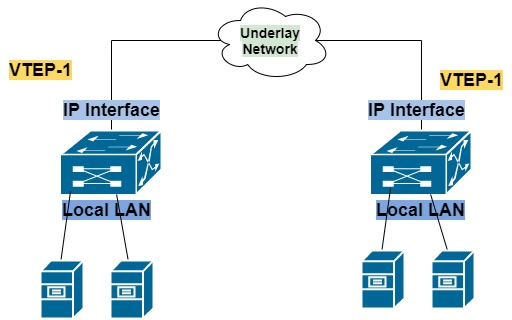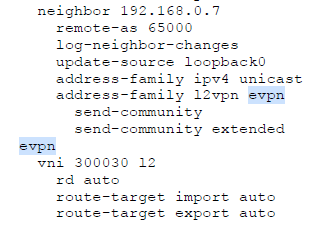What is the Use of BGP EVPN in VXLAN
As previously mentioned on how VXLAN resolves the Mobility (VMs can move anywhere from one data center to another location without any changes), Scalability (VLAN 4K to VXLAN 16 Million Logical Network), and encapsulation related limitation. Here we will know how traffic flooding is controlled by the EVPN and the use of BGP as a control plan for Overlay.
VTEPs ((Virtual Tunnel End Point) has two interfaces: one use to connect for local host and another user to IP identification in the core network for VXLAN encapsulation and Decapsulation.

VXLAN Underlay: – Underlay is IP routed link configured as a Point-2-Point (P2P) link. This is only between leaf and spine. Not between leaf to leaf. Best use to aggregate for all underlay links and use loopbacks, Loopback required /32. It is a track for overlay. For underlay, we can use EIGRP, OSPF, IS-IS protocol.
VXLAN Overlay:- Overlay is a virtual network it is a tunnel that runs on a physical underlay network whereas Overlay is similar to GRE Tunnel. The overlay is a layer 2 network that is used to carry the VXLAN layer 2 traffic and forward it to other VTEP. For Overlay, we can use the BGP protocol which is used as a control plan.
EVPN- (Ethernet Virtual Private Network)- To use EVPN we can reduce the flooding by turning off the BUM (Broadcast, Unknown unicast & Multicast) traffic. BGP use as the Control plane the MAC address propagates as the BGP prefix within the EVPN address family.
EVPN Route Types:-
The EVPN network layer reachability information (NLRI) provides different route types.
| S.No | EVPN Type | Description |
| 1 | Ethernet Auto-Discovery (AD) Route | Routes are only originated for multi-homed sites. |
| 2 | MAC/IP Advertisement Route | Advertise MAC, address reachability, advertise IP/MAC binding |
| 3 | Inclusive Multicast Ethernet Tag Route | Multicast Tunnel End point discovery |
| 4 | Ethernet Segment Route | Use to Redundancy group discovery, DF election |
| 5 | IP Prefix Route | To Advertise IP prefixes |
Work Flow of EVPN with Multicast- To prevent the ARP flooding it will suppress the ARP storms. The broadcast packet is only sent through Multicast which is defined for the specific Multicast Groups. This is the big advantage of using the multicast in VXLAN every packet will go through multicast not broadcast. In the multicast, we can use PIM (sparse or Dense Mode). To use Multi-Protocol BGP with address family of EVPN on VTEPs to distribute the internal host MAC or IP address, or external reachability information.
Basic Configuration for EVPN:-
If we are going to configure the EVPN on any vendor’s devices, ensure the feature should be enabled. Link, if we are using Cisco Nexus devices feature (“NV overlay EVPN”) should be enabled.
EVPN Responsibilities:
– VNI/VTEP Flood List Mapping (Type 3) and
– MAC/IP Address Propagation (Type 2),
– Mapping Destination to the Egress VTEP.
Conclusion:-
So, we can say that the flood & learn are controlled by BGP EVPN. EVPN is the address family of BGP, MAC address propagates as BGP prefix within the EVPN address family. EVPN type2 use for MAC/IP Advertisement Route.
Zindagi Technologies has been helping people in upgrading their business by giving them services like Data Center Services, Network Automation, IT consulting, Managed Services, and many more. With our help, you can take your business a step ahead. Let’s get to know more about you and your business. Call us on +919773973971.
Author
Brijesh Yadav
Network Consulting Engineer
